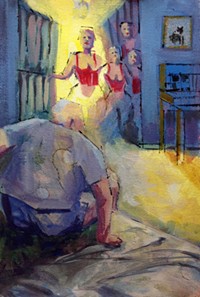What's My Name?
What's My Name? explores the experience of Alzheimer's patients and their caregivers
By Brian Staker @stakerizedWho are you? It's a question framed in a mirror: the reflecting pool of language. The phrase "I think, therefore I am" is, in a sense, accurate, and conveys the mental images and linguistic descriptions we give to ourselves. You can't detach "self" from "self-image," and when that image starts to become fractured, every element of our day-to-day existence is disrupted.
The exhibit What's My Name? at Art Access Gallery looks at Alzheimer's disease and dementia—degenerative diseases that decrease mental functioning—through works by artists who've either been caregivers to Alzheimer's patients, or patients themselves. In 2014, Sue Martin was caring for her father who had Parkinson's as well as dementia, and she found that art helped her cope with the emotional difficulties. She had been blogging about her experiences and started making paintings. "I was struck by how something creative every day saved my sanity," she says.
Martin noticed that Jerry Hardesty, another Salt Lake City painter, had started posting on Facebook a series he was working on about his mother's battle with Alzheimer's. The two put together a proposal to the nonprofit gallery, but they felt that their own works didn't tell a complete story. They took submissions, and the show—curated by Martin—also includes works by other artists whose lives have been touched by the disease.
Margaret Hill's paintings—which represent work created both before and after she was diagnosed, as well as later works she produced in collaboration with her partner Hardin—illustrate a mind in decline and become gradually more abstract but still possess a definite aesthetic sensibility. Even when Hill was in a care facility and losing her verbal ability, she still clung fiercely to the desire to create.
Leonard and Kathryn Romney's watercolors depict the fragmented nature of Kathryn's experience with the disease and her perception of beauty in the world, as well as Leonard's perspective as a caregiver. Still in the relatively early stages of her illness, Kathryn was able to attend the March 20 opening of the show.
There's a certain amount of pain inherent in this subject, and Hardesty's work channeled his emotional turmoil from experiences of visiting his mother, culminating in her not recognizing him and saying, "I don't have a son." The fear of being genetically predisposed to the malady prompted him to research it, resulting in the Seven Stages of Alzheimer's abstract series on panels. It's a stark delineation of the inevitability of decline and its ravages. Two of his other works illustrate questions from the Self-Administered Gerocognitive Exam, about identifying basic shapes and making change, and how such fundamental functions are impaired by the disease.
According to the Alzheimer's Association, one-third of deaths among people over 65 are due to Alzheimer's or other dementia, and the disease is the sixth leading cause of death in the United States. One of the most startling things about the disease is that, unlike cancer—which can often be sent into remission with treatment—there's no known cure. But art has been shown to improve quality of life, and even help maintain some mental acuity.
"Anything can happen to anyone at any time," notes Art Access executive director Sheryl Gillilan. "This show is a reminder of that, but maybe it's not as hopeless as you think."
As Alzheimer's has entered mainstream awareness, there's been less tendency to hide away. Leonard Romney recognized the value of humor in dealing with the disease. In an artist statement, he notes, "If my motive, rather, is to bring clarity, induce compassion and understanding or to have or create a smile or a tender remembrance, the gates spring open wide so the story may enlighten, enliven or even encourage."
Humor is also evidenced in Sue Martin's Lala Land series—which isn't made up of portraits of her father, but depictions of circumstances of the disease in a playful, whimsical manner. They show that patients can still enjoy pleasures as fundamental as ice cream or singing. Irene Rampton's portraits of her father include a collage about his mother, who had been a passenger on the Titanic, and it's a reminder that personal history lives on.
"The exhibit fits perfectly with our mission to tell untold stories," explains Gillilan. "If we can open up an avenue for people to cope with hardship and let them be heard, that's the power of art. The creative aspects of the brain are among the last to be affected, and it's a way to stay engaged with the world."
If we have learned anything from Alzheimer's, perhaps it's that we relate to the world through linguistic, symbolic interactions, and when we lose our connections to those symbols, we start to lose ourselves. This exhibit demonstrates the many ways art can keep us connected.
More by Brian Staker
-
Live Music Picks: April 12-18
Judas Priest, The Residents, Clownvis Presley, The Breeders and more.
- Apr 11, 2018
-
Loving the Alienation
Helios Creed and Chrome continue making iconoclastic music for outcasts.
- Mar 28, 2018
-
Live Music Picks: March 22-28
U.S. Girls, Ed Schrader’s Music Beat, Hell’s Belles, Columbia Jones and more.
- Mar 21, 2018
- More »



